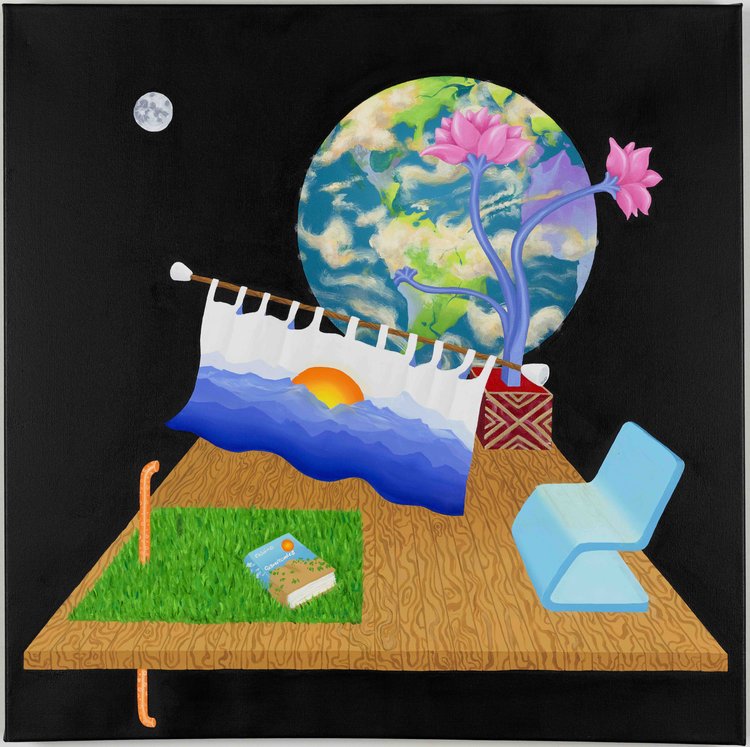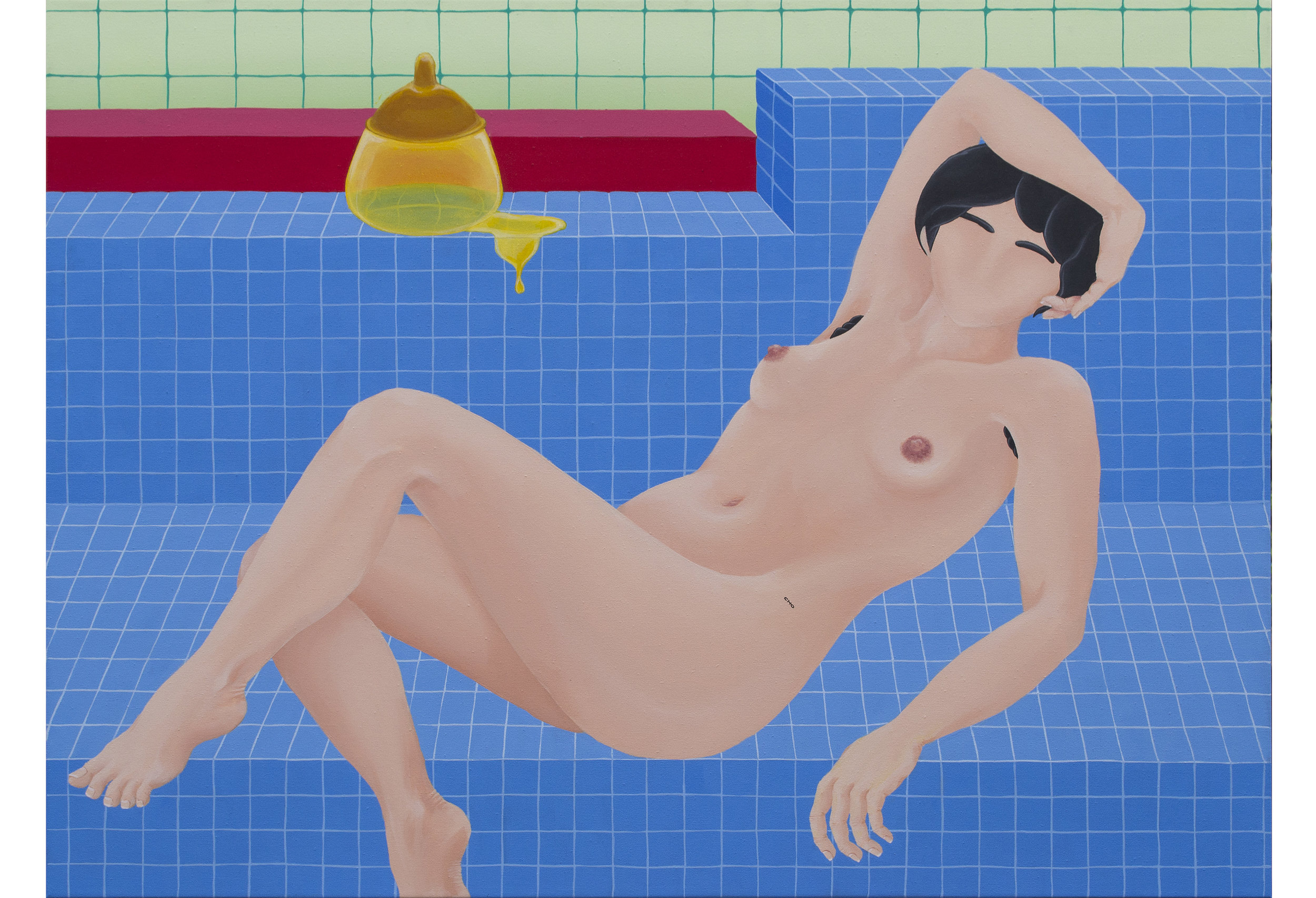Matisse in bath
2017-2018
Large reclining woman (2017)
28”x36”
Acrylic on canvas
Woman in pool with waves (2018)
28”x40”
Acrylic on canvas
Tobagon (2018)
48”x36”
Acrylic on canvas
Woman with hair in the air (2018)
40”x30”
Acrylic on canvas
On Interpreting Matisse
I first saw Matisse’s “Large Reclining Nude” at the Baltimore Museum of Art. Next to the painting, there is an explanatory plaque, showing how Matisse transitioned from precise depictions of the figure to more abstracted colors and shapes. It struck me that this generalization required rigor and imagination, and I decided to explore Mattisse’s paintings as a way to expand my understanding of creative expression.
Impressionists brought brilliant colors back to Western art after a period of realism, where light and shadow prevailed over color. Japanese ukiyo-e art prints influenced Impressionist painters, and this is evident not only in the colors, but also in the style and subject matter. Likewise, Matisse’s work is evocative of the flatness and colors of Japanese art, but also is reminiscent of decorative Islamic art, and sculptural African art. Through the synthesis of multiple cultures, Matisse created art works that tantalize and inspire so many people to this day.
My experiment in interpreting Matisse’ work is inspired by this possibility for synthesis across multiple ideologies and cultures. There is an advise from Cezanne to “deal with nature by means of the cylinder, the sphere, and the cone.” I approach painting with an appreciation for the complexities of our reality as a scientist, and I solve the challenge of representing this complexity. Einstein said, everything should be “made as simple as possible, but not simpler.” Painting Matisse interpretations presented me with the challenge of painting full continuous figures, which I had never done, and I approached this challenge by meeting a compromise between Matisse’ beautiful generalization of figure and my proclivity toward precision. I wanted these paintings to echo Matisse’s shapes and colors, but also create something new by merging my identity as an Asian woman and a scientist with Matisse’s.
Problems with nudes
Nudes are problematic and I was hesitant to create images that reinforce the particular existence of women that has been prevalent in the usage and conventions of Western art. From Berger’s Ways of Seeing: “To be born a woman has been to be born…into keeping of men… A woman must continually watch herself. She is almost continually accompanied by her own image of herself. Whilst she is walking across a room or whilst she is weeping at the death of her father, she can scarcely avoid envisaging herself walking or weeping.” In other words, women are less present than seen. Take Matisse’ reclining nude, for example; it’s a picture of a naked woman who is posing because she is aware of the surveyors’ gaze, including Matisse’s. So, I was conflicted about creating female nudes as objects to be seen. Painting these nudes, however, forced me to think about the implications of male gaze in women’s lives and how to resolve them in my own work.
How do I preclude the male gaze in female nude paintings? I concluded that if the figures are present, and are comfortable with their presences, then they are not merely posing to be seen; rather, they are daring to take up space in the world.
Traditional female nudes are often supine as if they lack strong spine to stand by herself. You take away the spine; women nevertheless survive, maybe with new found strength. In these paintings, the figures are quite spineless, but this spinelessness allows for certain vitality, with figures lunging, sliding, and jumping. The absence of features and orifices came about as a whim, but this strategy allowed me to avoid assigning individuality to these figures. In fact, they are not individuals; they are not even humans. They are derivatives of me, and all the things I have seen in my life with my female eyes.
These nudes were also fun to paint. Georgia O’Keefe never meant to paint human vulvae with her flowers, and insisted that her skulls were not meant to convey death; they were simply “nice things” to paint. I approached these nudes the same way. The nudes were fun to paint with all the complexity of bones and muscles hidden under the layer of skin.
Matisse Bath; a musical and visual candy
Paintings of this series have been produced as an album with Marc Miller.
From Marc Miller on this record:
Lo & Behold! The promise is at last a reality. In 2018, I set a goal to record every day, no matter what. 300+ recordings resulted (not 365, but I’ll take it). Once completed, they lacked a home or any sense of unifying direction until Spring of 2019, when Se Jong asked me to create a soundtrack for her painting series “Matisse In Bath.” Nearly sixty tracks were carefully chosen to create to a continuous two-hour loop of music to be played alongside the exhibition at Current Space, almost guaranteeing that no one person taking in the show would hear the same material repeated. Nothing further happened with this project until Gabriel Jermaine Vanlandingham-dunn came along with his new record label Cow Arts Program, seeking out what I had been up to musically in the past few years. He took the material under his wing, whittling down and curating the selections to create something that flowed to his liking and would fit on two LPs. And now it’s here – it exists in the world, so I can finally tell people!
https://marcmiller.bandcamp.com/album/matisse-bath
A video from a very special record release party, inside at Current Space with my little speech in the beginning:





